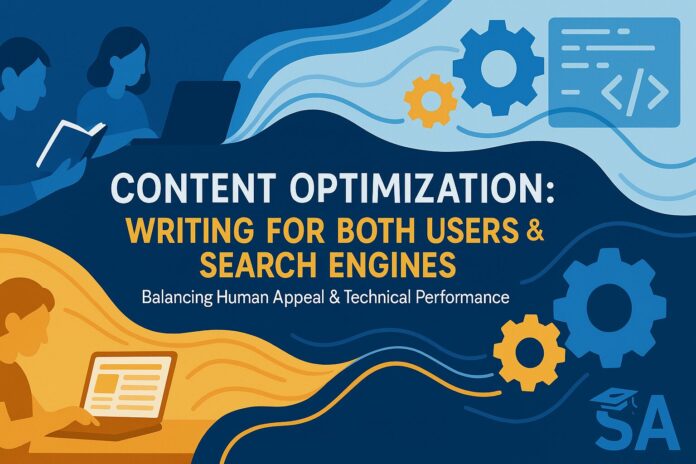The digital divide between highly visible content and buried pages runs deeper than most realize. Successful online content strikes a delicate balance—simultaneously engaging human readers while satisfying the technical requirements of search algorithms. In today’s competitive landscape, understanding content optimization isn’t just beneficial—it’s essential for any business hoping to establish meaningful online visibility.
This comprehensive guide explores the dual art of creating content that resonates with audiences while also performing well in search rankings. We’ll dive into strategic keyword research, effective on-page techniques, and critical technical considerations like mobile responsiveness and page speed. You’ll discover powerful off-page strategies for building authority and learn how to measure success with metrics that actually matter.
By the end of this article, you’ll have actionable strategies to elevate your content above competitors through thoughtful optimization. From structuring headings to building quality backlinks, these practical techniques will help position your content for maximum visibility. Let’s explore how to craft material that captivates readers and earns favor with search engines.
Understanding Content Optimisation
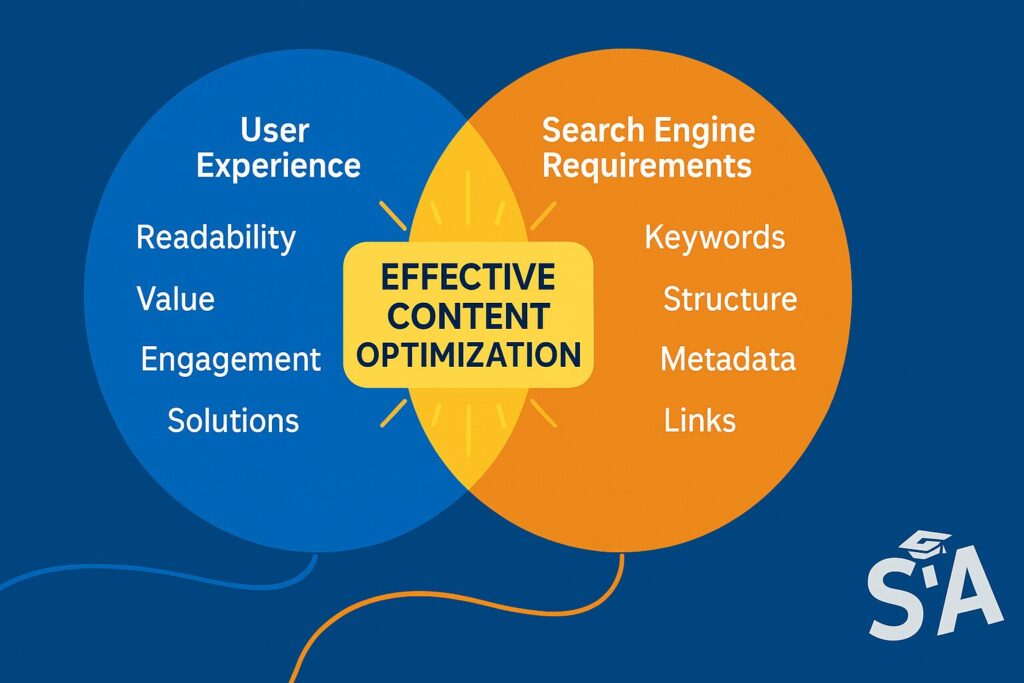
Purpose of Content Optimisation & Why SEO Writing Matters
Content optimisation serves a dual purpose: satisfying search algorithms while delivering genuine value to real people seeking answers. When you successfully balance these elements, you create a powerful foundation that drives sustainable traffic and builds audience trust. According to Search Engine Journal, effective SEO writing significantly increases your chances of connecting with your target audience when they need your solutions most.
Understanding this intersection between user behavior and algorithms reveals why optimization matters. Search engines analyze signals like dwell time, bounce rates, and keyword relevance to determine content quality. Moz’s research on ranking factors confirms these user interaction metrics heavily influence positioning. However, the ultimate goal remains human satisfaction—if visitors leave feeling disappointed, even the most technically optimized page will eventually lose ranking power.
Overview of SEO & Writing for Users vs. Engines
Effective optimization requires simultaneously addressing two distinct audiences. For human readers, this means implementing readable formatting, clear language, and digestible paragraphs that keep them engaged. For search engines, it involves providing structured data, logical heading hierarchies, and strategic keyword placement.
The most successful content creators don’t view this as an either/or proposition. According to Neil Patel, “The sweet spot happens when you write primarily for users while strategically incorporating SEO elements that help engines understand your content’s value.” This integrated approach transforms ordinary text into high-performance digital assets. By honoring both audiences’ needs, your content stands a significantly better chance of achieving visibility while delivering meaningful engagement.
Keyword Strategy & Creating Engaging Content
Keyword Strategy Essentials
Effective content optimization begins with intelligent keyword selection. Start by identifying what Backlinko calls “low-hanging fruit” keywords—terms with manageable competition that directly relate to your expertise. While high-traffic phrases offer tempting visibility potential, balancing them with achievable terms often yields faster results. Tools like SEMrush’s Keyword Magic Tool or Ahrefs’ Keywords Explorer can uncover valuable search patterns and competition levels, removing guesswork from your research process.
Once you’ve identified promising targets, focus on incorporating them naturally. The goal is addressing the underlying search intent—helping users solve problems or answer questions. For example, if targeting “technical SEO writing,” ensure your content genuinely delivers insights on that specific topic. HubSpot’s research shows that content closely matching search intent consistently outperforms loosely related material, regardless of keyword density.
Creating User-Centric Content for Global Audiences
User-centric content resonates because it prioritizes the reader’s experience over mechanical optimization. Content Marketing Institute’s report shows that audience-focused content generates 50% higher engagement rates than brand-centric material. This means understanding your readers’ geographic and cultural context matters—whether they’re browsing from Sydney, Singapore, or San Francisco.
For Australian audiences specifically, content that incorporates local examples and cultural touchpoints creates immediate connection. However, the fundamental principles of good content remain universal: clarity, relevance, and value. Breaking text into scannable sections with effective transition words helps readers follow your narrative regardless of location. According to Copyblogger, content with clear visual hierarchy and thoughtful formatting keeps readers engaged 80% longer than dense, unformatted text.
Optimising the Enhanced Content Section for Organic SEO
Enhanced content sections—featuring infographics, videos, and interactive elements—significantly impact both engagement and SEO performance. Search Engine Land reports that pages with mixed media elements earn 94% more views than text-only pages. These enhanced sections make content more engaging while providing additional ranking opportunities through properly optimized media.
For maximum SEO benefit, ensure all visual elements include descriptive filenames, alt text, and contextual placement. Google’s own guidance emphasizes that proper image optimization helps search engines understand your content’s comprehensive value. This meeting point between technical SEO and user experience design creates content that satisfies both algorithms and human readers simultaneously.
On-Page & Tech Considerations
On-Page Optimisation Techniques
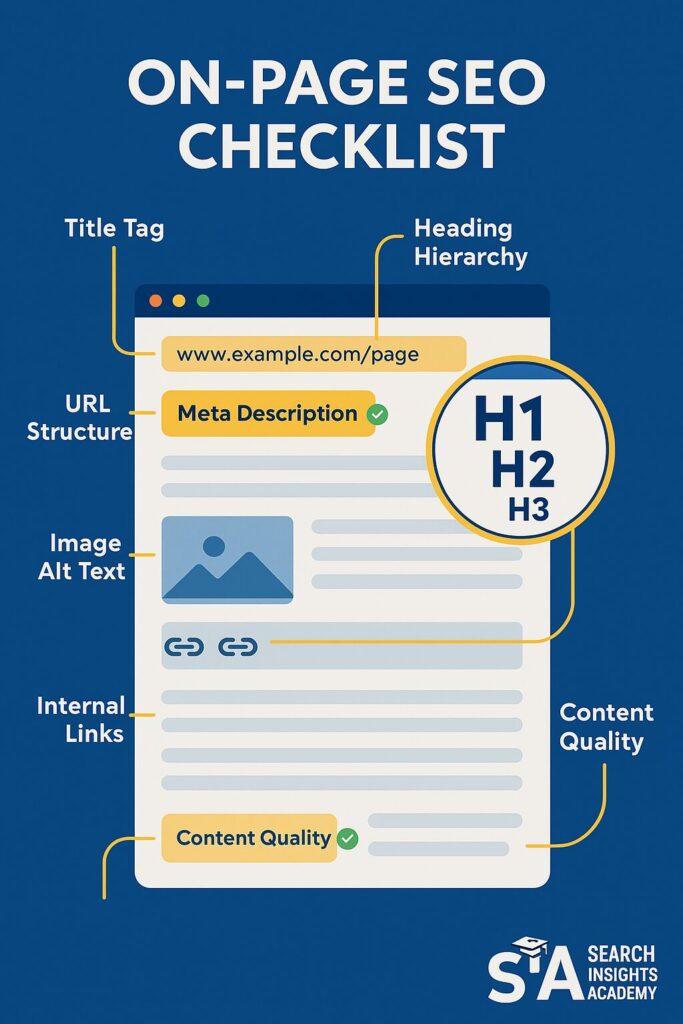
On-page optimization forms the foundation of content visibility. Meta tags remain critically important—Backlinko’s analysis of 11 million search results found that descriptive, keyword-optimized title tags strongly correlate with higher rankings. Similarly, crafting compelling meta descriptions can significantly improve click-through rates, even if they don’t directly impact rankings.
Heading structure creates both readability and SEO value. Implementing a logical hierarchy (H1, H2, H3) helps readers navigate your content while signaling topical organization to search engines. Search Engine Journal’s on-page SEO guide emphasizes that properly structured headings improve crawlability and user experience simultaneously.
URL structure also plays a significant role in optimization. Ahrefs’ research shows that descriptive, concise URLs containing target keywords typically outperform lengthy, complex ones. Even seemingly minor pages, like About Us sections, contribute to overall site authority—Orbit Media’s study found that well-optimized About pages increase site-wide conversion rates by establishing credibility and trust.
Technical SEO Writing & Mobile Friendliness
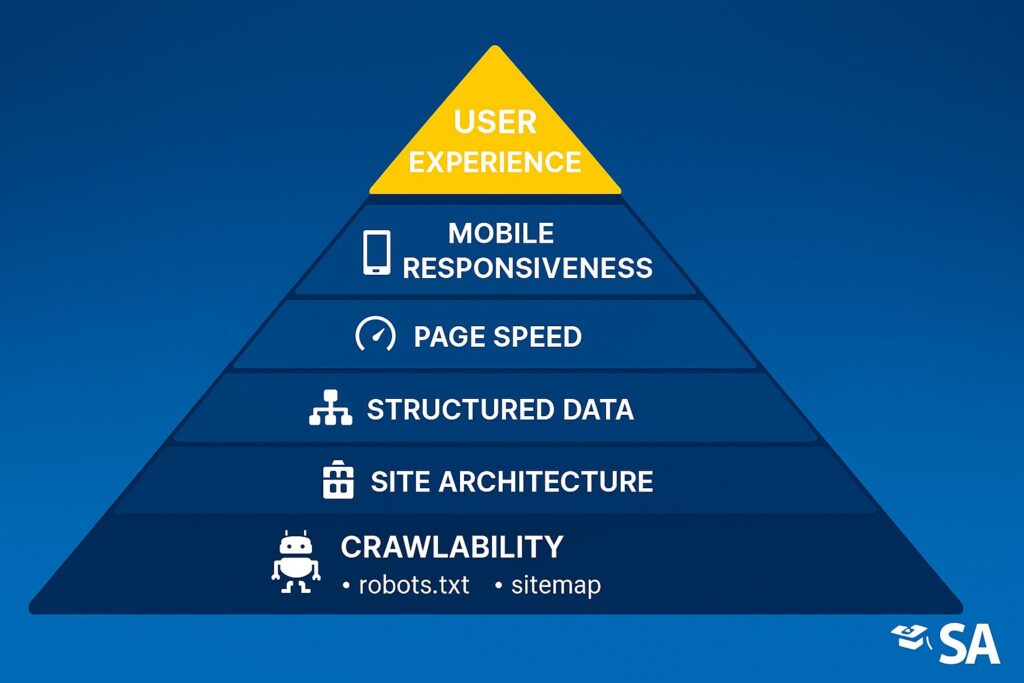
Technical SEO extends beyond keywords to include site architecture, indexing efficiency, and user experience metrics. With mobile devices generating over 60% of search traffic globally, mobile-friendliness has become non-negotiable. Google’s mobile-first indexing means sites are predominantly ranked based on their mobile experience, not desktop versions.
Page speed similarly impacts both rankings and user satisfaction. Google’s research shows that as page load time increases from one to five seconds, bounce probability increases by 90%. Implementing speed optimizations—like image compression, efficient hosting, and minimal code bloat—provides competitive advantage in search results while improving conversion rates across devices.
Site SEO Optimisation Tools & Methods
Effective optimization requires proper tools and measurement methods. Google Search Console offers invaluable insights into indexing status, search performance, and technical issues directly from Google’s perspective. Its integration with Google Analytics creates a comprehensive view of both traffic acquisition and on-site behavior.
For comprehensive site auditing, tools like Screaming Frog crawl websites to identify technical issues, while SEMrush’s Site Audit tool provides prioritized recommendations. The most effective approach involves gradual, measured changes rather than complete overhauls. Search Engine Journal’s case studies demonstrate that methodical improvements with careful tracking generally produce more sustainable results than radical site-wide changes.
Writing for Humans & Off-Page Tactics
Human-Friendly Copy & Natural Keyword Placement
The foundation of effective content remains genuine human connection. Nielsen Norman Group’s eye-tracking studies reveal that visitors scan digital content rather than reading word-by-word, making clear structure and natural language essential. Even as you optimize for search visibility, prioritizing readability ensures visitors engage with your message.
Natural keyword integration requires finesse. According to Content Marketing Institute, effective content typically mentions primary keywords 2-5 times in a 1,500-word article, with frequency adjusted based on content length. This approach maintains readability while providing sufficient signals for search engines. Reading content aloud often reveals awkward phrasing or forced keyword placement that might alienate readers.
Off-Page Optimisation & Authority Building

Off-page signals significantly influence search rankings. Moz’s research confirms that backlinks remain among the most powerful ranking factors, functioning essentially as votes of confidence from other websites. Building these signals requires strategic relationship development rather than manipulative link schemes.
Guest posting on established platforms creates mutual value when executed properly. The host site receives quality content while you gain exposure and authoritative backlinks. Ahrefs’ study of guest blogging shows that successful guest posts focus on providing genuine expertise rather than promotional content. This principle applies globally, including Australian markets where authenticity particularly resonates with audiences.
Quality Backlinks & SEO Web Gains
Link quality consistently outweighs quantity in modern SEO. Backlinko’s analysis of 1 million Google search results found that the number of domains linking to a page correlated with rankings more strongly than the total number of backlinks. This reinforces the importance of diverse, relevant link sources over volume-focused approaches.
Anchor text diversity also plays a crucial role in natural link profiles. Search Engine Journal’s research indicates that excessive exact-match anchor text can trigger spam filters, while a natural mix of branded, partial match, and contextual anchors appears more organic. This balanced approach creates sustainable authority that withstands algorithm updates while driving qualified traffic to your content.
Common Questions & Measurement
Why Is SEO Writing Important for Businesses?
SEO writing’s importance extends far beyond simple visibility—it fundamentally changes how businesses connect with potential customers. Unlike interruptive advertising, optimized content reaches people actively searching for solutions, creating higher intent interactions. HubSpot’s State of Marketing Report found that SEO leads have a 14.6% close rate compared to just 1.7% for outbound leads like direct mail or print advertising.
The long-term benefits of SEO writing create sustainable business advantages. While paid advertising stops generating traffic the moment campaigns end, well-optimized content continues driving visitors months or years after publication. Orbit Media’s blogging survey revealed that 76% of marketers report stronger results from content marketing than they did a year prior, demonstrating compounding returns over time.
Easiest Way to Start SEO for Website Content
For beginners, the incremental approach proves most effective. Search Engine Journal’s guide for beginners recommends starting with a content audit of your most important pages. Identify which existing pages generate traffic or conversions, then optimize their metadata, headings, and content quality first before expanding to less critical pages.
Creating a basic keyword strategy provides essential direction. Tools like Google’s Keyword Planner offer free insights into search volumes and competition levels. Focus initially on longer, more specific phrases (long-tail keywords) where competition is typically lower. According to Ahrefs’ keyword difficulty study, newer websites can gain traction faster by targeting specific queries rather than competing for broad, highly competitive terms.
Measuring Success & Making Continuous Improvements

Meaningful measurement focuses on outcomes rather than vanity metrics. Google Analytics provides essential tracking for organic sessions, engagement metrics, and conversion data. More importantly, it reveals user behavior patterns that inform content refinement. Pages with high bounce rates or low time-on-page metrics often need improvement regardless of their ranking positions.
Continuous improvement requires regular content audits and updates. Search Engine Land’s case studies demonstrate that refreshing older content with updated information, improved formatting, and additional depth can increase traffic by 111% on average. This approach maximizes the value of existing assets while maintaining relevance as search patterns and algorithms evolve.
Quick Wins & Next Steps
Practical Tips & Quick Wins
For immediate impact, implementing structured data offers significant returns. According to Schema.org and Google’s structured data guidelines, properly formatted schema markup helps search engines understand your content’s context, potentially earning rich snippets in search results. These enhanced listings dramatically improve click-through rates with relatively minimal implementation effort.
Internal linking provides another rapid improvement opportunity. Semrush’s internal linking study found that pages with more internal links pointing to them typically rank higher in search results. Reviewing existing content to add contextual links between related pages strengthens your site’s architecture while helping visitors discover additional relevant information.
Compelling calls-to-action dramatically impact conversion rates. WordStream’s CTA research shows that personalized CTAs perform 202% better than generic ones. Simple adjustments—using action verbs, emphasizing benefits, and creating urgency—can transform passive readers into engaged participants without requiring extensive development resources.
Collaborations & The Content Writer and SEO Combo
The synergy between quality writing and technical SEO creates results greater than either discipline alone. Content Marketing Institute’s research shows that 61% of the most successful content marketers integrate SEO strategy from content creation through measurement, rather than treating them as separate functions.
Strategic collaborations extend this principle beyond organizational boundaries. Guest posting, expert interviews, and co-created content open doors to new audiences while building valuable backlinks. For businesses targeting specific regions like Australia, partnering with established local sites provides contextual relevance that global platforms sometimes lack. According to BrightLocal’s Local Consumer Review Survey, 87% of consumers read online reviews for local businesses, making regional authority particularly valuable.
Future-Proofing Your Strategy
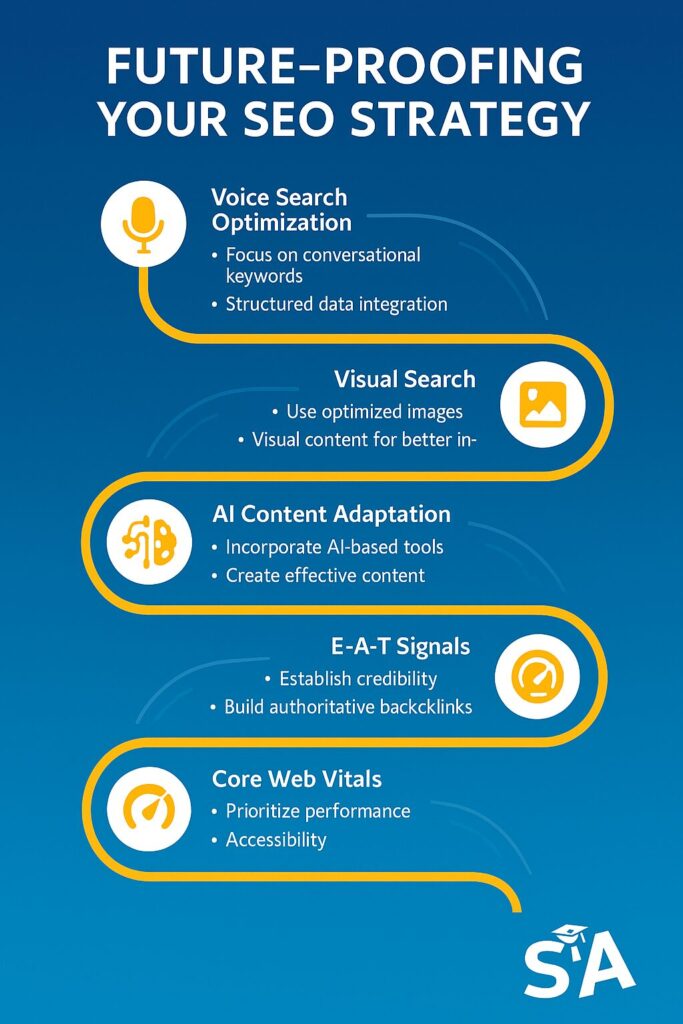
Emerging technologies continue reshaping search behavior and optimization requirements. Search Engine Journal’s voice search study indicates that voice queries now represent approximately 20% of all mobile searches, with distinctive patterns requiring adaptation. Similarly, visual search technologies from Google and Pinterest are changing how users discover content through images rather than text.
Algorithm evolution demands regular strategy refinement. Moz’s Google algorithm update history documents hundreds of changes annually, requiring vigilant monitoring and adaptation. Committing to regular content audits—at least quarterly for key pages—ensures your optimization efforts remain effective as search engines evolve. This proactive approach positions your content to benefit from algorithm changes rather than being penalized by them.
Conclusion
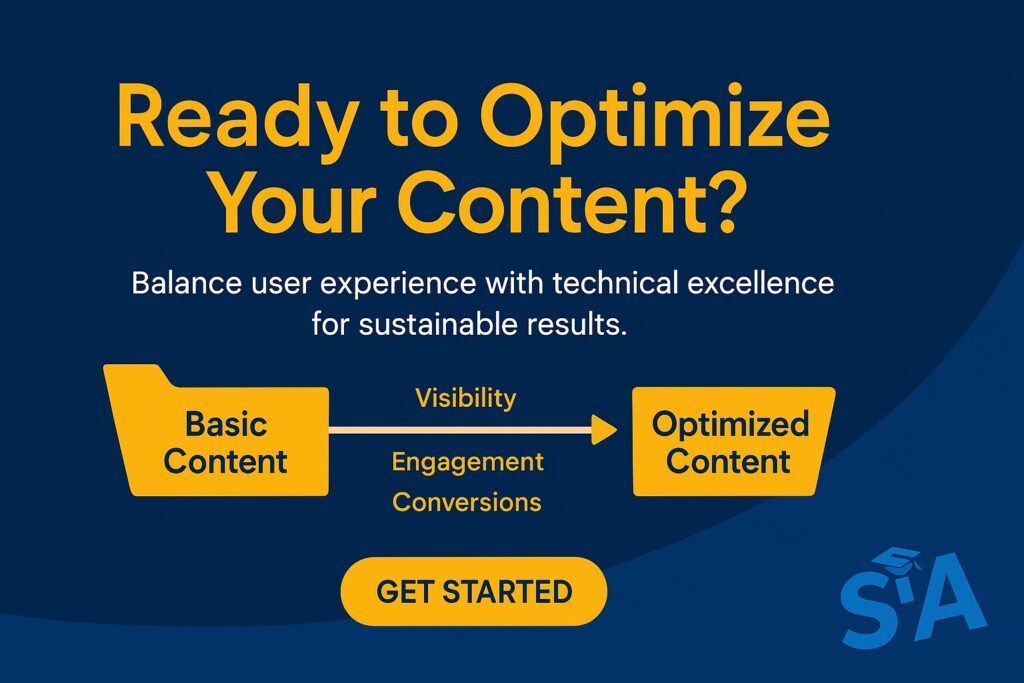
Recap of Effective Strategies for Site SEO Optimization
Throughout this guide, we’ve explored the multifaceted approach required for effective content optimization. From strategic keyword selection to technical implementation details, successful optimization balances technical requirements with genuine user value. We’ve examined how proper on-page structure, mobile responsiveness, and thoughtful off-page authority building work together to create content that performs well across metrics and markets.
Final Thoughts on SEO Websites in the Global and Australian Markets
Successful SEO transcends mechanical optimization to create genuinely valuable user experiences. In competitive markets worldwide—including Australia’s unique digital landscape—authenticity and relevance consistently outperform technical shortcuts. Whether targeting global audiences or specific regional markets, focusing on user needs while implementing best technical practices creates sustainable competitive advantage.
Next Steps to Achieve Sustainable Web SEO Optimization
Moving forward, commit to continuous improvement rather than one-time optimization. Regularly audit your content performance, refresh aging materials, and adapt to evolving search behaviors. By balancing creative content development with data-driven refinement, you’ll build a digital presence that not only ranks well but genuinely serves your audience’s needs. This balanced approach represents the future of content optimization—technically sound, audience-focused, and continuously evolving.

